Ruling Endangers Better Planning for City's Future
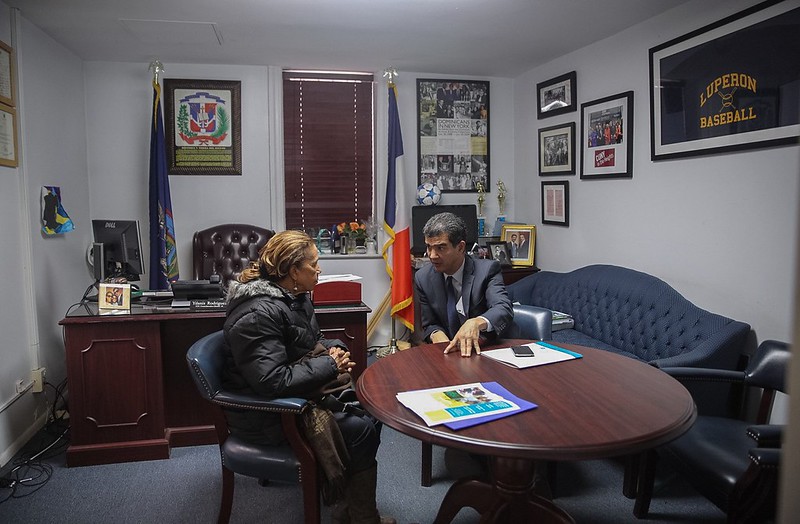
Council Member Rodriguez with a constituent (photo: William Alatriste/City Council)
Shortly before Christmas a judge of the New York State Supreme Court in Manhattan issued a ruling annulling the rezoning plan for Inwood that had been in the works since 2017 and was approved by the City Council in August 2018. The City has appealed the decision to the Appellate Division; the case may well go all the way to the Court of Appeals before it is finally resolved. But even if the decision is eventually reversed, this legal challenge has upended the long-established legal and political process for achieving rezonings and could have a detrimental impact on all future rezoning efforts in New York City.
Supreme Court Judge Verna Saunders found that a number of potential socio-economic impacts raised by community groups were not considered during the state- and city-required environmental review of the plan and sent it back to the Deputy Mayor for Housing and Economic Development to study and address these concerns.
While I am neither a land use nor an environmental attorney, it seems to me common sense that some of the highlighted issues are impossible to fully assess because they are speculative and depend on so many economic, legislative, sociological, and other factors beyond local zoning. For example, ambulance response times or the impact on minority- and women-owned businesses.
Other issues may well have been considered but not explicitly addressed in the environmental reports. For example, the impact of the loss of the neighborhood public library was addressed: the zoning plan adopted by the Council included a brand new, larger, and better-equipped public library in a new building with 175 affordable apartments and a plan for a temporary relocation while the new library building is constructed.
But the specifics of the judge’s decision are not as significant as the fact that it creates uncertainty about the validity of a lengthy public review process in which the Mayor and the locally elected City Council Member were actively engaged and the City’s Uniform Land Use Review Procedure was carefully followed.
The methodology for conducting environmental reviews of zoning proposals is set forth in a manual (the “CEQR Manual”) written and updated by a panel of experts that contains clear rules and standards for analysis. If litigation can successfully overturn a zoning plan by demanding that specific factors not included in the manual must be considered and addressed then there can be no certainty that any plan is final, no matter how robust the public and political review process and how carefully the standards of the manual have been followed.
The new buildings that were to be authorized by the Inwood rezoning, which would provide 1,300 units of affordable housing, are now on hold. The immediate consequences of derailing the zoning changes are that the demand for more housing in Inwood will force prices higher, not only depriving potential new residents of housing opportunities, but affecting current residents as well.
There may well be a broader impact. If, after three years of development, including 22 public meetings, input from the Community Board, the Borough President, the City Planning Commission, and Council approval, a rezoning plan can no longer be regarded as firm and final, builders will be reluctant to get involved in these efforts at the outset and neighborhoods that need them will miss out on thousands more affordable housing units.
Moreover, the role of the local City Council Member in providing input and negotiating additional community benefits as part of rezonings is called into question. Council Member Ydanis Rodriguez, who represents the Inwood neighborhood, succeeded in including hundreds of millions of dollars of benefits to the community as part of the plan, including the new library, improvements to the local public school complex and park and community spaces, and funding for local anti-displacement and homeless service programs. All of these investments are now in doubt.
If the duly elected representative who knows the needs of the area best cannot be relied upon to definitively sign off on behalf of his constituents, why would other Council Members put themselves out there to influence and endorse a plan?
Change is hard and can be frightening. But it will happen, either haphazardly through as-of-right development under existing zoning, or through a more managed growth process in a thoughtful and coordinated way, through the land use review process with the input of community leaders who help maximize the benefits for the people who live there. The activists who challenged the Inwood rezoning plan, though undoubtedly well-intentioned, may have won a battle but hurt the long-term health of the City by leaving officials with no clear path to follow in their efforts to keep the city’s neighborhoods thriving.
***
Carol Kellermann was president of Citizens Budget Commission from 2008 through 2018.
***
Have an op-ed idea or submission for Gotham Gazette? Email This email address is being protected from spambots. You need JavaScript enabled to view it.
Governor Cuomo Granted Me a Second Chance at Life; Many Others Deserve It Too

(photo: Kevin P. Coughlin/Governor's Office)
A year ago, almost to the day, Governor Cuomo gave me a second chance at life.
That is not an exaggeration. On October 26, 1988, I along with several co-defendants, was convicted of murder for my role in a robbery that went terribly wrong. The judge, known to be particularly harsh, sentenced me to 80 years to life. That meant that I would not be eligible for parole until I was 98 years old. I was 18 years old and facing the reality that I would die in prison.
I spent the next three decades fighting for my life. I quickly realized that I needed to come to grips with what I had done, and with what led me down that path. The process of introspection began with required programs, and I eventually was able to acknowledge and accept responsibility for my actions and the damage I had caused.
I steered clear of any disciplinary infractions. I participated in and completed all mandated programs; I even enrolled in programs I did not have to take. Thereafter, I decided to help others change their lives in a positive way. I facilitated, developed, and implemented new programs and embraced a role as a mentor to younger men in prison. Most significantly, I found my way through post-secondary higher education, obtaining two master’s degrees and completing a doctorate degree. I was dubbed the first inmate to complete a doctorate degree "during" incarceration. I was also the first prisoner in New York State history to create, manage, teach, and coordinate a college program run by an incarcerated person.
I was no longer the impulsive immature young person who gave little thought to the consequences of his actions, and I carried the victims of my crime in my heart as an inspiration to change the lives of people forever. I also carried the reality of dying behind prison walls.
With the help of my wife and carried along by devotion to my faith, I began to pursue the only path to freedom that was available to me: clemency. I submitted my application for clemency to the Executive Clemency Bureau and with the assistance of CUNY School of Law I was able to supplement the application with additional material, including evidence revealing the trial judge's reputation for biased, harsh sentencing.
On December 31, 2018, I was called to the front of the prison by the First Deputy Superintendent. I was the only person that was called, leading me to believe that I may have been the only one about to receive news about my clemency decision. I felt it in my soul that I was about to be granted a new lease on life. The feeling was so strong!
The deputy superintendent summoned me to an isolated area and read the governor's decision to me. I jumped up and yelled "Yes, yes, yes!" over and over again. Officers passed by observing the spectacle; shocked, they stood still to listen. I practically glided back to my cell.
Upon entry to my cell I immediately went into prayer and gratitude to God. A voice whispered in my ear to turn on the radio. When I turned it on, a scripture was quoted for the day from the Bible: "I am doing a new thing, can you feel it? I am moving like a stream in the desert. All things of old will stay in the past, and now all things are new." I felt a chill run down my back. The message felt specific to me, a modern-day miracle.
My emotions are impossible to put into words. The past year has been a dream. I had my doctorate degree delivered to my home and not to a prison cell, which was how I received mail for over 30 years. I have made over 60 appearances across New York State; speaking to many about the governor's mercy and how to change one's life through faith and love. I have even been a featured speaker about criminal justice reform at Yale University and CUNY School of Law. I have been on podcasts, interviewed at radio stations, met with artists, was mentioned in a rap song, and spoke at numerous churches, community groups, and even events hosted by government officials in- and out-side of New York.
Yet, as grateful as I am to Governor Cuomo for giving me my freedom, my heart remains heavy. I know that there are countless others in New York state prisons who have been redeemed. There are incarcerated men and women who work tirelessly within their wearisome and oppressive environments to transform themselves through introspection and action. I know this to be true. I have lived with many of these people in prison and know firsthand the people they have become. I also know of their genuine contrition and effort to repair the damage they caused.
Incarcerated men like Paul Clark, Delroy Thorpe, Benjamin Smalls, Ulysses Boyd, Lance Sessoms, Craig Jackson, and Richard Chalk mentor young and old men alike. They and so many others in prison have so much to offer society.
To be clear, I am eternally grateful to Governor Cuomo for granting my clemency application. I am well aware how rarely clemency is granted anywhere in this country. The joy of celebrating my first Christmas in 31 years at home still lingers. And yet, I carry profound sadness for men like Paul, Delroy, Benjamin, Ulysses, Lance, Craig, and Richard who remain destined to perish in prison. What, or whose, purpose does that serve?
I know well how people behind the walls die a little with each day closer to the end of December or in early January with no news about clemency. I know, too, the impact on their loved ones. Yet while 2019 has come and gone, and the governor commuted the sentences of two people on Friday, Three Kings Day, also called the Feast of the Epiphany, is yet to come. As free people celebrate a new year, I pray that the governor, in the spirit of forgiveness and mercy that marks the holidays, has his own personal epiphany and finds it in his heart to give to many others the gift of clemency that he gave to me.
***
by Roy Bolus
***
Have an op-ed idea or submission for Gotham Gazette? Email This email address is being protected from spambots. You need JavaScript enabled to view it.
Why the Charter School Proposals by Bernie Sanders and Elizabeth Warren Shouldn’t Be Controversial

(photo: Michael Appleton/Mayor's Office)
Recently, a group of charter school supporters received media attention by protesting at an Elizabeth Warren campaign event, claiming she wants to shut down all charter schools. This is categorically untrue. No one, not Elizabeth Warren, not Bernie Sanders, not even public school advocates like ourselves, is pushing to unilaterally shut down existing non-profit charter schools.
Rather, both Warren and Bernie Sanders have released plans that demand a bare minimum of accountability from existing charter schools -- including financial and operational transparency and requirements that they serve all students. Both presidential candidates also propose ending the federal grant program for new charter schools, imposing a moratorium on charter expansion, and banning for-profit charter schools.
As a former charter school parent and a former charter school teacher, we support these proposals – and we believe, that if implemented both at the federal level and with a similar approach at the state level, this agenda would actually improve charter schools while also limiting some of the harm they have done to district public schools.
First, a little about our experiences, which are, sadly, far from unique.
I, Liat, spent my first year teaching at a Brooklyn charter school that was started by non-educators and suffered from extreme turnover in administrators and staff. We had six principals over the course of the first year, and ten teachers either quit or were fired. We also lost special education students because our school wouldn’t or couldn’t provide the services they needed. Instead, they were sent to nearby public schools. Now that I work in a public school in District 14, we experience the reverse process -- my school has no choice but to accept the many students pushed out by charter schools when they don’t conform to their rigid academic or behavioral expectations.
I, Fatima, am a single mother whose son was suspended over 30 times by his charter school, Upper West Success Academy, starting in first grade, including for very minor issues, such as walking up the stairs too slowly. He was also denied his mandated special education services, which worsened the situation. The school demanded that I pick him up so frequently in the middle of the day that I was forced to drop out of college myself. When I finally pulled him out of the school, his therapist told me he suffered from symptoms of post-traumatic stress.
Then when my son and I were subsequently interviewed on the PBS Newshour about how he had been treated at the school, Success Academy officials at the network sent copies of his disciplinary files, full of trumped-up charges, to every education reporter they could find and posted it online. Eva Moskowitz, the Success Academy CEO, also recounted false stories about his behavior in her published memoirs.
Although the US Department of Education eventually found her and the school guilty of violating the federal student privacy law called FERPA more than three years after I filed my initial complaint, Success officials have refused to comply with the law and continue to retaliate in the same way against other parents who dare to speak out against the unfair treatment of their children by releasing their confidential files to reporters. Meanwhile, the New York State Education Department has confirmed that Success Academy has systematically failed to provide students with their mandated special education services, even after having been ordered to do so by hearing officers.
Since my son left Success Academy, he is slowly recovering, and is now doing better in high school, but it took him years to undo the damage he experienced. I have met many other parents whose children suffered similar or worse fates. Success Academy charters are currently facing five different federal education lawsuits for violating student rights, and yet are the fastest growing charter chain in the state of New York, having received more than $60 million in grants from the federal government since 2006 to aid in their expansion and replication.
Now let’s look at the Warren and Sanders proposals, which call for more accountability and oversight for the charter sector.
Both senators say if elected president, they would end the federal grant program known as the Charter School Program (CSP) that funds new charter schools. Aside from funding the expansion of chains like Success, a recent report revealed that this grant program has awarded more than $1 billion in start-up funds to charters that failed to open or quickly closed. At the same time, both candidates support increasing federal Title I funding, which would financially benefit most charter schools as well as district public schools that serve a high-poverty student population.
Warren would quadruple Title One funding, increase IDEA funding for students with special needs, and press states to boost their own education funding and make it more progressive. Sanders would triple Title I funds, increase IDEA funding, and provide schools with more funding to reduce class sizes. Charter schools would be eligible to receive all of this funding as well as public schools.
At the same time, both candidates also call for stronger charter oversight, and would ban for-profit charter schools and those that outsource operations to for-profit managers, which have been found to be particularly prone to fraud. And both call for a moratorium on charter school growth, following the lead of the NAACP and Black Lives Matter, which have made this a central point in their advocacy, because charter schools have worsened school segregation and the school to prison pipeline through "no excuses" disciplinary practices that lead to excessive suspensions and expulsions.
The NAACP has also expressed concern about how, increasingly, public funds are “diverted to charter schools at the expense of the public school system,” even as many public schools already lack the resources they need to provide a well-rounded education.
Here in New York City, charter schools siphon more than $2.1 billion per year from the Department of Education’s budget, and take up an increasing amount of space in public school buildings, where more than half-a-million students suffer in overcrowded buildings. If the city refuses to offer space to new charters in public schools, they must help pay for their rent in private spaces, which is costing taxpayers an additional $100 million a year. A recent report from Class Size Matters found that the DOE has been paying millions of dollars each year to charter schools to rent space in buildings owned by their charter management company or an affiliated LLC or foundation.
In 2013, the credit rating agency Moody’s warned investors that the rise in charter school enrollments would likely cause negative pressure on public school budgets. Several studies since have confirmed that charter expansion has caused serious harm to district finances in Pennsylvania, North Carolina, and California, putting at risk these essential democratic institutions.
We support parent “choice” as long as this doesn’t undermine the ability of children, wherever they attend school, to receive a quality education in safe and caring learning environments. But many charter school advocates do not seem interested in basic accountability and transparency measures that would benefit students enrolled in both charter and DOE public schools. Rather, “choice” has become a euphemism for another aim -- not to improve or defend existing charter schools -- but to dismantle and eliminate as many traditional public schools as possible. This is the end-game of many of the charter movement’s billionaire backers, like the Walton family, the Koch brothers, and Betsy DeVos.
By articulating a need for minimal accountability so that charter schools operate equitably and humanely, and by ending special federal funding streams that encourage unchecked charter growth, Elizabeth Warren and Bernie Sanders are simply trying to ensure that all students are able to attend schools that will help them thrive academically, socially, and emotionally. There should be no controversy about these essential goals.
***
Liat Olenick is a public school teacher in Brooklyn. Fatima Geidi is a parent.
***
Have an op-ed idea or submission for Gotham Gazette? Email This email address is being protected from spambots. You need JavaScript enabled to view it.
As Albany Considers Regulations, Gig Economy Workers Must Be Heard
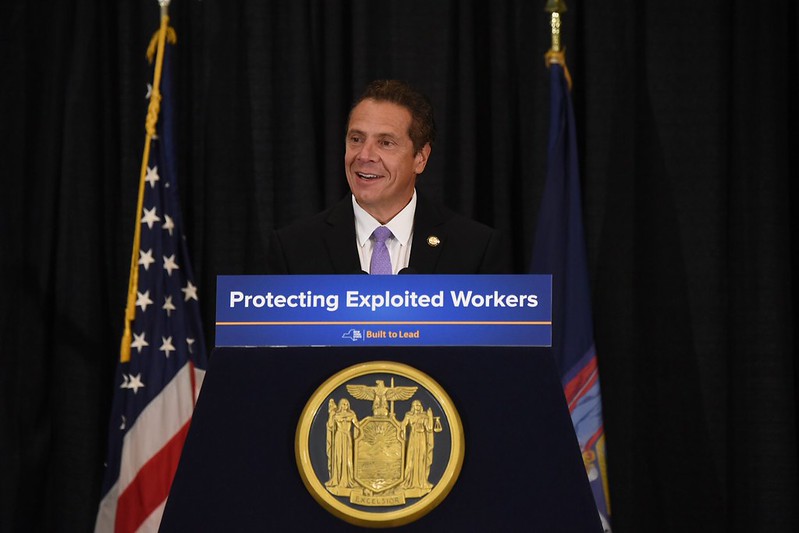
(photo: Don Pollard/Governor's Office)
I recently attended a fascinating panel on a topic that will be hotly-debated in Albany in 2020 – the regulation of the gig economy workforce. I listened to representatives from organized labor. We heard from spokespeople from technology platforms like Postmates and DoorDash. There were academics. There were even public officials, such as State Senator Diane Savino, the sponsor of a bill that could radically shift the nature of work for hundreds of thousands in New York State.
Know who was missing from the panel? Gig economy workers themselves. And their voices must be heard.
We already know where the labor unions stand. They are pushing hard to get Uber drivers, Door Dashers, and Task Rabbits reclassified from independent contractors (who have no right to unionize) to traditional employees (who do). With union membership eroding the last 50 years, organized labor needs to regain relevance, and getting jurisdiction over the fast-growing gig workforce is a ripe chance for it to do so. The unions have strong relationships, built over decades, with lawmakers in Albany. And, with the recent backlash against big tech, the timing is right for them to act.
We also know what the technology companies want: the status quo. They have built their companies, and fortunes, on the premise that their drivers, dashers, and dog walkers are independent contractors who log on when they want and earn what they can. Some tech platforms are now discussing offering limited benefits, such as retirement and health plans, for their freelancers. But the potential full reclassification of their workforces represents an existential threat to these companies.
The tech companies are scared. And, while they don’t have many friends in Albany, they have piles of money to hire lobbyists and advisors to gear up for this fight. In California, where a law was recently passed attempting to clarify the issue, the tech platforms have pledged $90 million to support a ballot initiative that would exempt their workers from the legislation.
What we still don’t know, in California, New York, or anywhere else, is what the workers themselves want. Do most prefer the autonomy, if unpredictability, that comes with being your own boss? Or would the majority of them rather a more conventional but stable work arrangement?
So far, these workers have been getting lost in the shuffle. Last year, in an effort to protect drivers from falling earnings, the New York City Council passed a law requiring the ride-sharing apps to pay $17.22 per hour minimum wage. The unions declared a victory. But the drivers ended up getting shafted, when (predictably enough) Uber and Lyft began limiting drivers’ hours in response, leaving them worse off. Unable to stay profitable under these new rules, Juno – founded, ironically enough, as a driver-friendly alternative to Uber and Lyft – went bankrupt last month.
For sure, gig economy workers are not monolithic. The freelance graphic artist in DUMBO might not want the same working arrangement as the single mom cleaning houses in Crown Heights. Some people crave a 9-to-5, while others seek nontraditional hustles. One thing is for sure: we should not assume what any of them want. And we should not trust the unions or tech companies to speak honestly for these workers when their own hides are so much at stake.
Won’t the legislative process adequately hear these workers’ voices? That’s wishful thinking. We can’t expect the average Lyft driver to call his state senator or show up to testify at a public hearing in Albany, if he even knows it’s taking place.
Instead, neutral researchers should be tasked to survey gig economy workers across the state. Journalists must go interview these workers in the streets – not just the hand-picked few put forward by the unions and tech companies at their press conferences. And state legislators must devise ways to hear from all their constituents, not just those who know their way around the State Capitol.
This is a high-stakes game of chess between two powerful factions, labor unions and technology companies. Gig economy workers must not be the pawns.
***
Sean Basinski founded the Street Vendor Project at the Urban Justice Center and was, until 2019, its director. On Twitter @SeanBasinski.
***
Have an op-ed idea or submission for Gotham Gazette? Email This email address is being protected from spambots. You need JavaScript enabled to view it.
Even Amid Impeachment Chaos, New Yorkers Must Keep Their Eyes on Albany
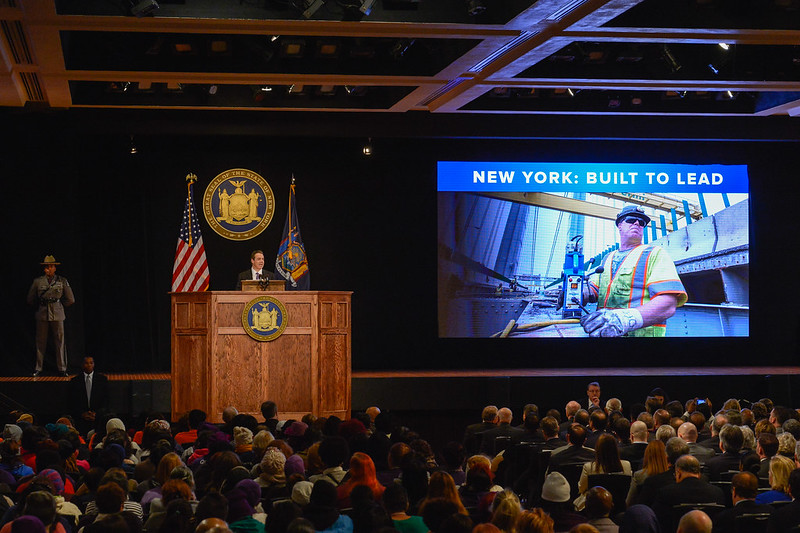
(photo: the Governor's Office)
With the eyes of the world focused on the impeachment frenzy currently consuming Washington, D.C., New Yorkers would do well to remember the maxim made famous by the late, great House Speaker Tip O’Neill: “All politics is local.”
On Wednesday, just one week into the new year and the new decade, Governor Andrew Cuomo will deliver his annual State of the State address – which kicks off the legislative session and unveils his yearly legislative and budgetary priorities. While most New Yorkers may not watch the midday event filled with pomp, circumstance, and two hours of a powerpoint presentation wrapped in Albany-speak, they should – however – pay great attention to the general themes of what the governor will lay out.
This speech will most likely set the tone for the following five-plus months of legislative activity in our state capital and may have repercussions down the road in Washington and around the country. New York State, after all, has a long and storied history of serving as a laboratory for legislative successes, going back to former New York Governor Franklin D. Roosevelt’s New Deal, some of which was borrowed from programs and laws already in place here.
Among the items Cuomo may touch upon in his State of the State are such issues as the looming budget deficit, digital data privacy, cannabis legalization, economic development, education, and healthcare. These are all topics that either Cuomo himself or state legislators have referenced as priorities for the coming session. Any one of these issues is certain to be contentious, divisive, and result in heated arguments among the powers that be and – more importantly – at kitchen tables around the state.
Some of these items, especially many of the bigger ones, may be incorporated into the final budget agreement to be reached between Cuomo and legislative leaders, usually by the first week in April (this governor, after all, prides himself on his administration’s near-perfect record when it comes to on-time budgets). However, there may still be a few items that will not make it into the budget and will need to be debated in public as well as in private and could ultimately be worked out on the floor of the New York State Assembly and Senate for all to see.
While legislators typically have until the end of June to work out any pending compromises, this year the last date of the legislative session in Albany is currently scheduled for June 2.
With a truncated session in Albany, there may be a rush to move items through the process faster than usual, so that incumbent members facing primary challenges can get home to campaign for reelection. In light of the 2018 elections, where more than a handful of Assemblymembers, State Senators and – of course – one prominent member of Congress lost their bids for their party’s nomination, the 2020 primaries will be something to see.
The speed of the legislative process in mind, New Yorkers need to remain vigilant. If there is legislation residents support or oppose, they should take the time to call their elected representatives and tell them so. Believe it or not, these members and their staffs like to hear this information and these calls help them to make an informed, rational decision.
While all 19 million New Yorkers may not be in the room where it happens (to reference another famous state resident), we need to all remember that we are the ones affected by decision made by our elected officials and that all the members of our state legislature work for the people. There are ways to get involved, stay involved, influence policy and effect change for ourselves, our families, and our neighbors for the better and for future generations.
That begins with paying close attention to Albany. So let that be our collective New Year’s resolution.
***
Julie Miner is the CEO of J Strategies, Inc., a communications and government relations firm based in New York City and Albany. On Twitter @JulieKMiner.
***
Have an op-ed idea or submission for Gotham Gazette? Email This email address is being protected from spambots. You need JavaScript enabled to view it.
Real Criminal Justice Reform Requires Standing Up to Fear-Mongering
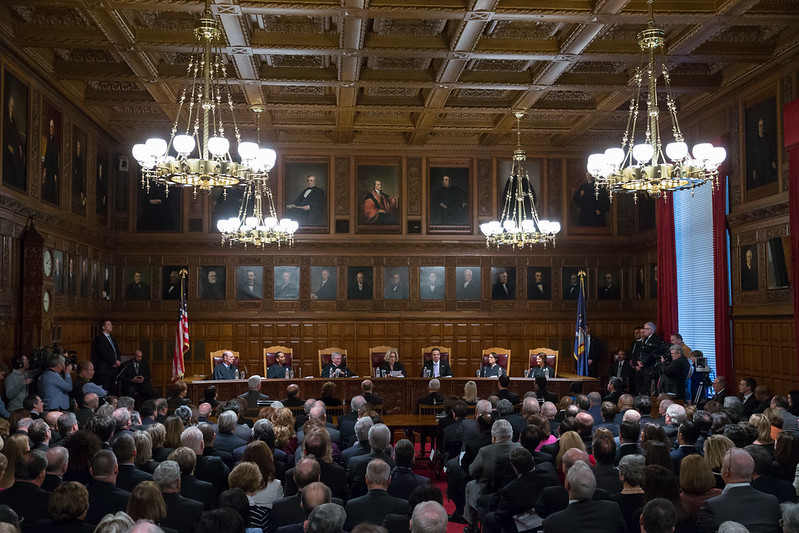
(photo: Governor's Office)
Nearly five years ago, Jerome Murdough, an African-American Marine Corps veteran, died on Rikers Island due to a combination of injustice, inhumanity, and medical neglect. Afflicted by homelessness and mental illness, Murdough tragically passed away when temperatures in his cell reached 100 degrees – heat that was contraindicated with his medicine – and he baked to death. The reason for this death sentence: He was cold one night and sought shelter in a public housing stairwell, where he was arrested for trespassing and jailed on $2,500 bail.
All across the country, in response to tragic injustices like those faced by Jerome Murdough, the movement to end mass incarceration is making real gains. After decades of oppressive policies, many policymakers are pursuing real solutions to shrink jail and prison populations and challenge the racial disparities that define the criminal legal system.
Reformers may have the momentum, but that doesn’t mean that the pro-mass incarceration lobby is finished. The lobby includes regressive prosecutors and sheriffs, as well as bail bonds companies that profit from the status quo. In New York, it looks a lot like they’re just getting started again, and their tactics are likely a preview of what we’ll see across the country as people demand more reforms.
Last April, when Governor Cuomo signed historic criminal legal system reforms into law, New York took a huge step towards addressing the systemic inequities of our current bail and discovery laws. The new laws, which take effect today -- January 1, 2020 -- will dramatically reduce the number of people held in pretrial detention and prevent prosecutors from unjustly withholding evidence.
No longer will our bail laws allow tens of thousands of people in poverty to be jailed every year while facing only alleged misdemeanors and non-violent felonies while the wealthy pay bail and remain free until and unless they receive a sentence upon conviction. No longer will our discovery law blindfold people to the evidence, a practice that has fueled wrongful convictions, ruined lives, and cost millions in legal settlements.
These reforms respond to the urgency of a system that often allows a person’s race and income to determine their freedom -- a system that tramples on the idea that a person is innocent unless they are proven guilty.
And now, as we begin implementation, those with a vested interest in keeping this system unfair for low-income New Yorkers and people of color are trying to scare lawmakers into undoing the fragile progress. They are mobilizing across the state with dire warnings of what might go wrong – as if people are not hurt by the existing system every day.
As public defenders, we see firsthand the impact that jailing has on the criminal legal system, as we routinely represent clients who languish in jail for months, if not years, simply because they are unable to afford bail money. They miss milestones like graduations, weddings, and funerals while they are detained away from their families and friends, losing jobs and housing, and even losing their children to foster care -- all without ever having been convicted of anything. Not to mention the grave risk to their lives: 372 people have died in New York City jails since 2001.
Many of the people we serve feel immense pressure to plead guilty simply because it would get them out of jail quicker than waiting for a trial would. Research shows that being held in pretrial detention increases both the likelihood of conviction and the length of prison sentences, though many are released from jail after accepting a plea deal.
Prosecutors understand the power and leverage that a broken pretrial system offers them, wielding that unfair advantage to coerce plea deals: 95% of all cases end in plea deals or dismissals, not trials. Adding to the unjust and coercive nature of this system, the vast majority of all of these pleas are negotiated with one side left in the dark because of the discovery law.
Of course, prosecutors want to roll back these reforms. The old system helped artificially increase their conviction rates, or to appear “progressive” by authorizing alternatives to detention that include constant and invasive surveillance when a person should be released outright pending trial. A deck stacked in their favor helps ensure they exercise outsized control over outcomes, regardless of the facts of a case.
When prosecutors claim that these pretrial reforms will result in ‘criminals’ running free and skipping their court dates – dehumanizing and inaccurate language, to be sure – it is important to remember that charitable bail funds already prove them wrong. For example, Bronx Freedom Fund found that 96% of the more than 2,500 people for whom they paid bail — each and every one presumed innocent — attended all of their court dates; 55% of those cases were entirely dismissed.
Moving past the fear-mongering, it’s important not to lose sight of the victims of the old system. It is people like Jerome Murdough and Kalief Browder and India Cummings and Robert Ingalsbe and Selmin Feratovic and Layleen Polanco who have lost their lives because of brutal jail conditions and the violence and despair they breed.
New York must show the nation that we can make real strides toward justice in our criminal legal system. Too many lives have already been ruined not to implement these reforms as required under the law.
***
Justine Olderman is the Executive Director of the Bronx Defenders. Lisa Schreibersdorf is the Executive Director of Brooklyn Defender Services. Tina Luongo is the Attorney-in-Charge of the Criminal Defense Practice at the Legal Aid Society. Stan German is the Executive Director of New York County Defender Services. Matt Knecht is the Managing Director of Neighborhood Defender Services of Harlem.
***
Have an op-ed idea or submission for Gotham Gazette? Email This email address is being protected from spambots. You need JavaScript enabled to view it.
A New Year’s Resolution to Save Lives: Do The Dutch Reach
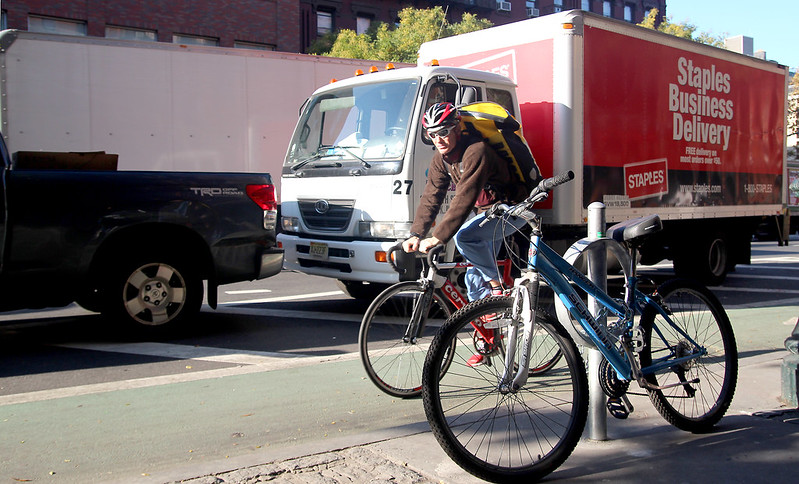
(photo: New York City Department of Transportation)
One of the New York City Department of Transportation’s bicycling safety tips, “Watch out for car doors,” seems straightforward until a door unexpectedly opens and catapults you into oncoming traffic. Several of this year’s bicycling fatalities came from dooring incidents, an action for which drivers face a whopping $150 fine and slap on the wrist if they face any consequences at all. The driver who doored me earlier this month on Fulton Street in Brooklyn seemed perfectly indifferent to the situation.
Opening a car door carelessly is illegal, and not just in New York City. Article 24 of the United Nations 1968 Vienna Convention on Road Traffic prohibits opening a vehicle door “without having made sure that to do so cannot endanger other road-users.” Though the United States is not one of the 36 signatories or 78 parties bound by the convention, much of America follows similar rules, including New York.
Despite Mayor de Blasio’s commitment to Vision Zero, which aims to eliminate traffic-related deaths in the five boroughs, cycling fatalities are on the rise. De Blasio’s original plan had noble aims, including: strengthen laws that punish unsafe driving, amend driver education to improve car-bicycle interactions, redesign priority intersections, and add new bike lanes to our streets. Five years later, we have 82 miles of new bike lanes, a large number of redesigned intersections, and more failure-to-yield summonses, but otherwise a wishlist of legislative activity and a single dooring-related line in the New York State driver’s manual. All the while, 29 cyclists have died this year, each story an unnecessary tragedy. To call these crashes “accidents” is to ignore that there was a driver sitting behind the wheel, or opening a car door, every time a vehicle barrelled into someone.
New York City is facing monumental challenges as it enters a new decade. Our subway is languishing. NYCHA housing conditions are deplorable. We need to build new borough-based facilities for our jail population. And climate change may flood us before we address any of these. With so many competing priorities, I understand why bicycle safety is not at the top of most people’s lists.
But looking out for cyclists before opening a car door is a straightforward fix to a devastating problem. In a time when we can be overwhelmed by the complexity of our city’s troubles, let alone what’s happening nationally and globally, looking before you open could be the easiest life-saving New Year’s resolution you’ve ever made.
City Council Speaker Corey Johnson talks about breaking New York City’s “car culture” with new bike lanes, bus lanes, and pedestrian plazas. His plans sound great, but they will take time. And during that time, cyclists will continue to die. We need to also think smaller and take some personal responsibility for the safety of our streets. If every driver and passenger looked carefully before opening a car door, using a simple practice called the Dutch reach -- using one’s far hand to pull the handle while also looking to see if it’s clear -- we would have a safer city. No new construction required.
 Dutch reach reminder (by Barbara Beckwith via Dutch Reach Project)
Dutch reach reminder (by Barbara Beckwith via Dutch Reach Project)
I do not pretend that cyclists are without blame. I have seen them ignore traffic lights, swerve in and out of bike lanes, salmon, and ride in darkness without any reflective gear or lights. These irresponsible cyclists give us all a bad reputation. Ultimately, though, there is an uneven power dynamic at play: my bicycle and I weigh a combined 165 pounds compared to a car’s approximately 3,900. When I ride, I strap some styrofoam to my head, which pales in comparison to a car’s airbags and crumple zones. If there is a turf war for space on the road, the outcome is simple: my bicycle and I will lose. Anyone who pretends cyclists and vehicles are on a level playing field has never been thrown into traffic by an unexpectedly opening door.
2020 should be the year cycling fatalities plummet to zero, and we don’t need to wait for long-promised infrastructure to make it happen. (A green stripe of paint along a narrow street doesn’t seem like much protection anyway.) One simple way to reduce the number of cyclists who die on our streets is to look before we open our car doors. It sounds almost silly in its simplicity. But it will save lives.
***
Benjamin Heller is a graduate student at NYU's Robert Wagner School of Public Service. On Twitter @BenjaminHeller0.
***
Have an op-ed idea or submission for Gotham Gazette? Email This email address is being protected from spambots. You need JavaScript enabled to view it.
New York City Needs Design-Build; The Governor's Signature Can Deliver It
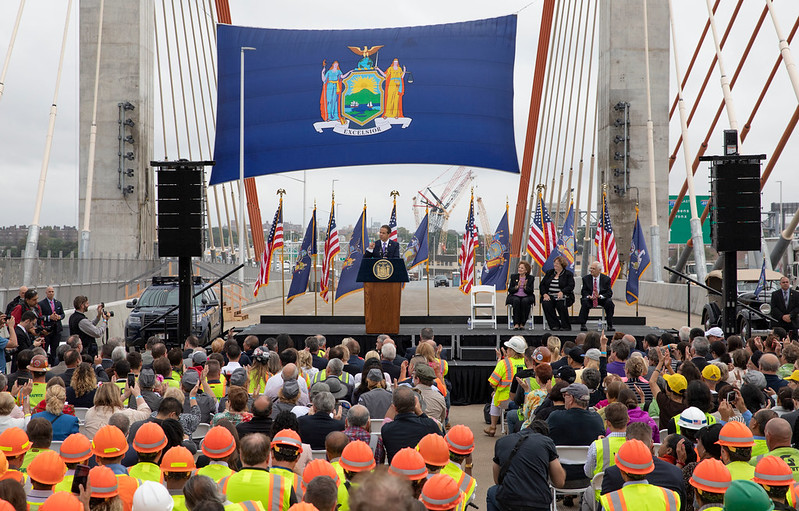
(photo: Mike Groll/Governor's Office)
New Yorkers are famous for our limitless ambition, but the City’s potential is limited by our government’s ability to build and improve public infrastructure to advance equity, speed commutes, adapt in the face of climate change, and boost our economic competitiveness. Simply put, we can’t grow if we can’t build our public infrastructure. Thankfully, Governor Cuomo can expedite construction and repairs to schools, hospitals, roads, bridges, and much more, cost-effectively, by signing the NYC Design Build Act.
The NYC Design Build Act amends the procurement laws in two important ways: it allows the city government to combine a project’s architects, engineers, and construction teams into one contract and one collaborative team. This way, the design team is forced to wrestle with the issues of construction costs and schedules in a way they do not do today. Second, the NYC Design Build Act would allow New York City to choose construction contractors that can deliver the best value along a range of factors including quality, innovation, and schedule, as opposed to just choosing the lowest bidder.
These changes will encourage better planning and understanding of the total costs of the project up front, which should clear many of the risks and delays that cause these projects to drag on interminably.
Going forward, the Legislature should extend the common-sense design-build strategy to all state and city agencies. The Legislature must find other ways to reduce the cost of operating and maintaining the infrastructure we already have, including through public-private partnership legislation. Otherwise, New York City will fail to keep pace with our peers in the nation and around the world. But, in the meantime, the NYC Design Build Act is a good first step, and we encourage Governor Cuomo to sign it.
***
Assemblymember Robert Rodriguez represents parts of Manhattan and is the Assembly sponsor of the NYC Design Build Act. Sarah Fitts and Jamie Rubin are members of the Regional Plan Association Board. Fitts is also an attorney working in energy and infrastructure; Rubin is CEO of Meridiam North America, which develops infrastructure projects in the United States and Canada, and was former Commissioner of New York State Homes and Community Renewal.
***
Have an op-ed idea or submission for Gotham Gazette? Email This email address is being protected from spambots. You need JavaScript enabled to view it.
What’s Really Been Missing from the Democratic Presidential Debate Stage

(photo: NYCHA)
Another Democratic presidential primary debate is now behind us, and once again not a single question has been asked about how our next President will address one of the federal government’s biggest failures of the last half-century – the neglect and divestment in our nation’s public housing.
Candidates across the board are developing new and exciting progressive policies that have energized the Democratic electorate (including many around affordable housing). But this central issue of restoring public housing, once a glowing achievement of American civic life, has remained notably absent from the debate stage, not to mention federal budgets as well.
That’s why we want to bring attention to real solutions, like H.R. 4546, the Public Housing Emergency Response Act, which is federal legislation to invest $70 billion to make emergency repairs across public housing in the United States. This includes funding that would finally meet the New York City Housing Authority’s (NYCHA’s) $32 billion need for capital repairs.
Every presidential candidate should be supporting this bill. Every major paper in the United States should be endorsing it. And that’s why we are kick-starting the conversation here in New York with a new Resolution in the New York City Council calling for the bill’s passage.
The ceding of federal responsibility over public housing has led to too many petty fights between New York City and State over funding the nation’s largest municipal housing authority. While NYCHA lost a cumulative $1.34 billion in federal capital grant funding since 2001, it took years of activism to release just $450 million in promised state funding this year. And that only represents roughly 1/64 of the capital dollars needed to fully address repairs.
We often remember Mayor Fiorello LaGuardia and ask why our leaders today aren’t making the same impact on our city’s affordable housing stock. Yet, we too often leave out LaGuardia’s partner in that effort – President Franklin Delano Roosevelt, whose Housing Act of 1937 provided for subsidies from the federal government for local public housing agencies.
We need real federal involvement again if we’re ever going to restore public housing to its former glory, and that will only happen if this crisis is addressed and discussed on the national stage in the manner it deserves, including at presidential debates.
That doesn’t mean we should give officials in City Hall or Albany a free pass either. The City and State must step up this year and contribute billions more dollars in their own budgets, and we will be calling on our colleagues in the Council and State Legislature to fight for this as well.
In the meantime, public housing advocates must be ready and waiting for a Democratic presidency, where this bill could finally fix the leaks, mold, and inhospitable living conditions that many of our nation’s 1.2 million public housing residents struggle with every day. That means starting the conversation now -- and what better place than the primary debates.
We have to have a dialogue about the thousands of residents at NYCHA’s Gompers Houses in our districts, who spent Thanksgiving and almost certainly will spend Christmas and the New Year without gas for cooking holiday meals.
We need to listen to the countless families who flood elected officials’ phone lines from October through April with fears of lost heat on a cold winter night.
While our offices will always be there for our NYCHA residents, whether it’s by distributing thousands of meals like we did on Thanksgiving, or working to get spot repairs made and mobile heaters brought in, these are simply band-aids on an ever-growing infection.
And in a worst case scenario, that $32 billion infection could rapidly metastasize to nearly $69 billion in unmet capital needs in just nine years, according to the new 2020-2024 financial plan just approved by NYCHA’s board.
It’s time that the federal government stop ignoring public housing. NYCHA and other housing authorities need to be fully funded so that residents receive their basic human right to safe housing. We know our current President, with his long record of violations of the Fair Housing Act during his time in real estate management, is unlikely to do anything. But we need this presidential primary, and the candidates running in it, to be held to a higher level of accountability, and we must ensure they fight to fix this public housing emergency once and for all.
***
Carlina Rivera represents District 2 in the New York City Council and has authored a Council resolution supporting H.R. 4546, the Public Housing Emergency Response Act. Nydia Velázquez represents New York’s 7th Congressional District and is the author of H.R. 4546. On Twitter @CarlinaRivera & @NydiaVelazquez.
***
Have an op-ed idea or submission for Gotham Gazette? Email This email address is being protected from spambots. You need JavaScript enabled to view it.
Paid Personal Time is the Right Thing To Do - and Benefits Both Workers and Employers
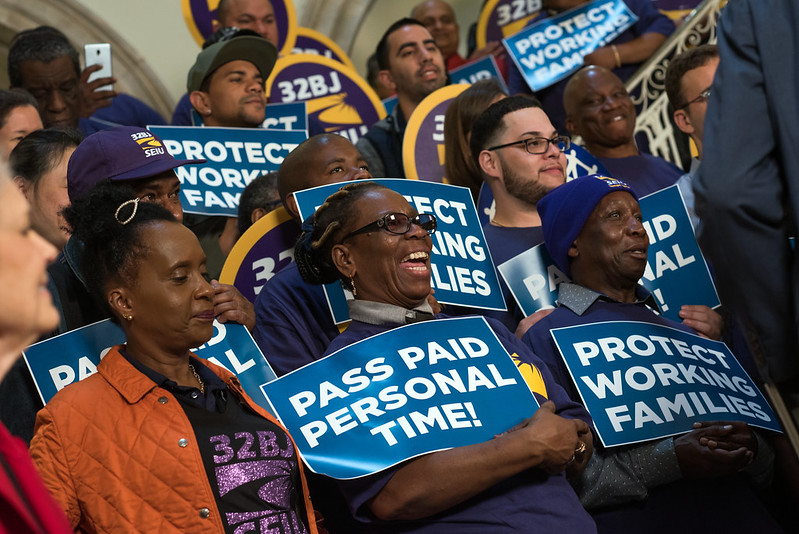
(photo: Ed Reed/Mayoral Photo Office)
As a small business owner of a toy company in Brooklyn, and a working mother who employs a nanny and a house cleaner, I am standing up in support of the Paid Personal Time bill under consideration in the New York City Council. This piece of legislation would ensure that over a million New Yorkers, including domestic workers and other workforces, would have the right to paid vacation time, something I take for granted as an employer.
One of the biggest motivations I had to be self-employed, was to have “the right” of having paid time off. I knew that by working for someone else, the right to paid vacation days wasn’t secured. As an employer and working mother, I can take the time I need to care for myself and be present for life’s special moments – taking my kids to their first day of school, seeing them graduate. I wouldn’t miss these moments for the world and it’s inhumane to think that some of the hardest working people in our city who need a break the most are denied this right.
I know firsthand how an investment in workers pays dividends for employers. The success of my business and the caring environment at home for my children both depend on the hard labor of all my employees.
At home, I provide my nanny almost six weeks paid vacation per year. I am also considering providing paid time off to our house cleaner in 2020 and have already started the conversation with her about signing up to Alia, a benefit program that provides paid time off to house cleaners.
At work, my business provides 16 days of paid vacation time and sick days annually to nine full-time employees. Additionally, my business partners and I are in talks to offer paid personal time to our two part-time employees next year.
While these high-road practices definitely impact our bottom line, it pays off in the loyalty and dedication of our workforce. I know that having a happy and well-rested team contributes to the successful and productive results for my company. We all win.
Passing paid personal time, we are also advancing women’s rights. From my 11 employees, 10 are women. As women, we know what it feels like to not be respected as a worker. For example, in the United States we don’t have a law to ensure paid maternity leave, affecting millions of working mothers and their children. My company, however, provides 12 weeks of paid parental leave for full-time employees.
With Paid Personal Time we have an opportunity to set standards for gender equality. All employees should be treated as full human beings who have lives outside of work. For example, in November, which is the beginning of the high season for our business, one of my employees took paid personal time for her wedding. Our team came together to make that possible by preparing our strategy in advance and making sure other employees could cover her daily tasks.
As an employer, I strongly believe we can be good employers and have a successful business. I want my employees to balance their job with showing up and honoring the other aspects of their lives. If my employees feel treated with dignity and respect, they will be happier and more fully themselves. My family and business benefit from it too.
I understand that passing Paid Personal Time would demand that we add more vacation time required by the law, and that it might create an additional financial cost. However, it would also mean that families will take time off to eat in restaurants, go shopping, travel, and provide an injection to our local economy. I want my business to reflect my values in treating people with respect no matter what. I accept that this is the ethical cost of doing business and know that at the end I am building a strong and loyal team of employees.
When I became an employer I knew I wanted to do the right thing for my employees.
For all of these reasons, I urge the City Council to pass Paid Personal Time and bring our city up to the standards of London, Paris, Tokyo, and other places that already guarantee this right for all workers. Let’s all make the necessary commitments recognizing equality and fairness for all workers and employers.
***
Emma Katz is a member of Hand in Hand: The Domestic Employers Network since 2018, the CEO of Hazel Village, a toy company located in Brooklyn, and a resident of Jackson Heights, Queens.
***
Have an op-ed idea or submission for Gotham Gazette? Email This email address is being protected from spambots. You need JavaScript enabled to view it.
With Youth Suicide Rates Rising in New York, Now’s Not the Time to Cut State Funding for Mental Health Treatment

(photo: the Governor's Office)
Rates of youth suicide are climbing across the country. New York State, where youth suicide is the second leading cause of death for adolescents, is no exception. With adequate investment in mental health and substance use services for children and adolescents, many of these deaths could be prevented. Yet, New York is planning to further reduce access to these kind of behavioral health services for children, even as more than half of children across the state with a mental or behavioral health condition do not receive the treatment they need.
At the end of 2019, New York State plans to cut reimbursement rates for behavioral health services for Medicaid-eligible children and families offered under Children and Family Treatment and Support Services. These critical and sometimes life-saving services include community psychiatric supports and treatment, family peer support services, crisis intervention, rehabilitation from substance use, and more.
At a time when children and families are chronically underserved and unable to access needed mental health treatment options, the state must place an immediate moratorium on any cuts to children’s behavioral health services to ensure they can receive the high-quality care they need and are legally entitled to.
Under federal and state law, commercial insurance companies and Medicaid programs must provide mental health and substance use benefits that are equal to coverage for physical medical treatments. But the reality looks far different for New York children and families.
In the 2016-2017 school year, roughly half of children in New York State with a mental or behavioral condition who needed treatment or counseling did not receive it. One study found that 55.1% of youth with major depression did not receive any mental health services in New York.
These numbers are less surprising when you consider that for every 10,000 children in New York, there are only two child psychiatrists. In rural areas, that number is often zero.
There simply aren’t enough trained medical professionals or public investments to meet the need, in part due to low pay for staff and the subsequent issues of high turnover and recruitment challenges.
When an overworked staff member quits or an agency is forced to no longer offer a service, it is children and families who suffer.
What do we do? Where do we go? The state must answer these questions and one more: how can we justify moving forward with these cuts while our children and family suffer? We are talking about an entire generation of our most vulnerable children who won’t get the help they need.
The data alone makes this clear. But in our work at Families Together in New York State, we see the individual children and families behind each statistic.
We see school counselors and social workers without the resources to meet the mental health needs of their students. We see students unnecessarily hospitalized or pushed into the juvenile justice or child welfare systems because they did not get the care they needed when they needed it. We see families struggle to find the quality services their children need to thrive.
As part of the rollout of Children and Family Treatment and Support Services (CFTSS) in 2019, the state estimated that 200,000 children would be eligible to receive behavioral health services under the program. However, only 7,800 children are currently receiving CFTSS, which is less than 5 percent of eligible children.
This under-enrollment is due to a number of factors, including under investment and a delay in start-up funds, which lead to issues like entire regions of the state lacking a designated provider of any of these services and families traveling several hours just to get an assessment. The bottom line is that we are not reaching nearly the number of children the state promised to serve, and the state is about to move ahead with its plan to reduce rates for these services.
Reducing access to mental health care services at a time like this moves New York State in the wrong direction for children’s mental health. That’s why Families Together is one of 40 leading behavioral health providers and child advocacy organizations across the state calling on Governor Cuomo to place an immediate moratorium on all cuts to behavioral health care for children. The current reimbursement rates for CFTSS services must be maintained to ensure children and families can receive the quality mental health care they need.
Mental health is a right for every child. New York State can and must do better for the children and families struggling to find adequate, high-quality mental health and substance use services. With the wellbeing and safety of our youth in the balance, we ask that the state do its part and stop these cuts.
***
Paige Pierce is CEO of Families Together in New York State.
***
Have an op-ed idea or submission for Gotham Gazette? Email This email address is being protected from spambots. You need JavaScript enabled to view it.




